Limited Effects of Long-Term Repeated Season and Interval of Prescribed Burning on Understory Vegetation Compositional Trajectories and Indicator Species in Ponderosa Pine Forests of Northeastern Oregon, USA
Abstract
1. Introduction
2. Materials and Methods
2.1. Study Area
2.2. Experimental Design
2.3. Field Sampling
2.4. Statistical Analyses
3. Results
3.1. Treatment-Level Differences in Community Composition
3.2. Treatment-Level Community Trajectories over Time
3.3. Treatment-Level Indicator Species Analysis (ISA)
4. Discussion
5. Conclusions
Author Contributions
Funding
Acknowledgments
Conflicts of Interest
Appendix A
| Code | Scientific Name | Family | Group |
|---|---|---|---|
| ACMI | Achillea millefolium ssp. lanulosa | Asteraceae | native perennial forb |
| AGOS * | Agoseris spp. | Asteraceae | native perennial forb |
| AGSP | Agropyron spicatum | Poaceae | native perennial grass |
| AMAL | Amelanchier alnifolia | Rosaceae | native perennial shrub |
| ANMI | Antennaria microphylla | Asteraceae | native perennial forb |
| ARCO | Arnica cordifolia | Asteraceae | native perennial forb |
| BERE | Berberis repens | Berberidaceae | native perennial shrub |
| BRCA | Bromus carinatus | Poaceae | native perennial grass |
| BRTE | Bromus tectorum | Poaceae | exotic annual grass |
| CAGE | Carex geyeri | Cyperaceae | native perennial sedge |
| CARO | Carex rossii | Cyperaceae | native perennial sedge |
| CARU | Calamagrostis rubescens | Poaceae | native perennial grass |
| CEVE | Ceanothus velutinus | Rhamnaceae | native perennial shrub |
| CIVU | Cirsium vulgare | Asteraceae | exotic biennial forb |
| CLRH | Clarkia rhomboidea | Onagraceae | native annual forb |
| COLL * | Collomia spp. | Polemoniaceae | native annual forb |
| COPMIG * | Collinsia/Microsteris Group | Scroph.\Polem. | native annual forb |
| CREP * | Crepis spp. | Asteraceae | native perennial forb |
| CRTO | Cryptantha torreyana | Boraginaceae | native annual forb |
| ELCI | Elymus cinereus | Poaceae | native perennial grass |
| ELGL | Elymus glaucus | Poaceae | native perennial grass |
| ERCO | Erigeron corymbosus | Asteraceae | native perennial forb |
| ERHE | Eriogonum heracleoides | Polygonaceae | native perennial forb |
| ERIC | Ericameria spp. | Asteraceae | native perennial shrub |
| FEID | Festuca idahoensis | Poaceae | native perennial grass |
| FRVI | Fragaria virginiana | Rosaceae | native perennial forb |
| GAAP | Galium aparine | Rubiaceae | native annual forb |
| GEVI | Geranium viscosissimum var. nervosum | Geraniaceae | native perennial forb |
| HIAL2 | Hieracium albertinum | Asteraceae | native perennial forb |
| HYCA | Hydrophyllum capitatum | Hydrophyllaceae | native perennial forb |
| KEGA | Kelloggia galioides | Rubiaceae | native perennial forb |
| KOCR | Koeleria cristata | Poaceae | native perennial grass |
| LOTR | Lomatium triternatum | Apiaceae | native perennial forb |
| LUCA | Lupinus caudatus | Fabaceae | native perennial forb |
| MEFU | Melica fugax | Poaceae | native perennial grass |
| MOPE | Montia perfoliata | Portulacaceae | native annual forb |
| ONAG * | Onagraceae spp. | Onagraceae | native annual forb |
| PHAC * | Phacelia spp. | Hydrophyllaceae | native perennial forb |
| PHLO | Phlox longifolia | Polemoniaceae | native perennial forb |
Appendix B
| Code | Scientific Name | Family | Group |
|---|---|---|---|
| PODO | Polygonum douglasii | Polygonaceae | native annual forb |
| PONE | Poa nervosa var. wheeleri | Poaceae | native perennial grass |
| POSE | Poa secunda | Poaceae | native perennial grass |
| PRUN * | Prunus spp. | Rosaceae | native perennial shrub |
| RICE | Ribes cereum | Grossulariaceae | native perennial shrub |
| SEIN | Senecio integerrimus | Asteraceae | native perennial forb |
| SIHY | Sitanion hystrix | Poaceae | native perennial grass |
| SIME | Silene menziesii | Caryophyllaceae | native perennial forb |
| SIOR | Sidalcea oregana | Malvaceae | native perennial forb |
| SOMU | Solidago multiradiata var. scopulorum | Asteraceae | native perennial forb |
| STIP * | Stipa spp. | Poaceae | native perennial grass |
| SYMP * | Symphoricarpos spp. | Caprifoliaceae | native perennial shrub |
| TAOF | Taraxacum officinale | Asteraceae | exotic perennial forb |
| THFE | Thalictrum fendleri | Ranunculaceae | native perennial forb |
| VIPU | Viola purpurea | Violaceae | native perennial forb |
References
- Naveh, Z. Effects of fire in the Mediterranean region. In Fire and Ecosystems; Academic Press: New York, NY, USA, 1974; pp. 401–434. [Google Scholar]
- Wein, R.W.; Maclean, D.A. The Role of Fire in Northern Circumpolar Ecosystems; John Wiley & Sons: New York, NY, USA, 1983. [Google Scholar]
- Agee, J.K. Ecology of Pacific Northwest Forests; Island Press: Washington, DC, USA, 1993. [Google Scholar]
- Bond, W.J.; Keeley, J.E. Fire as a global ‘herbivore’: The ecology and evolution of flammable ecosystems. Trends Ecol. Evol. 2005, 20, 387–394. [Google Scholar] [CrossRef] [PubMed]
- Cooper, C.F. Changes in vegetation, structure, and growth of south western pine forests since white settlement. Ecol. Monogr. 1960, 30, 29–164. [Google Scholar] [CrossRef]
- Parsons, D.J.; DeBenedetti, S.H. Impact of fire suppression on a mixed-conifer forest. For. Ecol. Manag. 1979, 2, 21–33. [Google Scholar] [CrossRef]
- Johnston, J.D.; Bailey, J.D.; Dunn, C.J. Influence of fire disturbance and biophysical heterogeneity on pre-settlement ponderosa pine and mixed conifer forests. Ecosphere 2016, 7, e01581. [Google Scholar] [CrossRef]
- Stephens, S.; Fry, D.; Franco-Vizcaíno, E. Wildfire and spatial patterns in forests in northwestern Mexico: The United States wishes it had similar fire problems. Ecol. Soc. 2008, 13, 10. [Google Scholar] [CrossRef]
- Collins, B.M.; Lydersen, J.M.; Fry, D.L.; Wilkin, K.; Moody, T.; Stephens, S.L. Variability in vegetation and surface fuels across mixed-conifer-dominated landscapes with over 40 years of natural fire. For. Ecol. Manag. 2016, 381, 74–83. [Google Scholar] [CrossRef]
- Koontz, M.J.; North, M.P.; Werner, C.M.; Fick, S.E.; Latimer, A.M. Local forest structure variability increases resilience to wildfire in dry western U.S. coniferous forests. Ecol. Lett. 2020, 23, 483–494. [Google Scholar] [CrossRef]
- Agee, J.K.; Skinner, C.N. Basic principles of forest fuel reduction treatments. For. Ecol. Manag. 2005, 211, 83–96. [Google Scholar] [CrossRef]
- Ryan, K.C.; Knapp, E.E.; Varner, J.M. Prescribed fire in North American forests and woodlands: History, current practice, and challenges. Front. Ecol. Environ. 2013, 11, e15–e24. [Google Scholar] [CrossRef]
- Jewell, S.; Vilsack, T.J. The National Strategy: The Final Phase in the Development of the National Cohesive Wildland Fire Management Strategy. United States Department of Agriculture-United States Department of Interior; 2014. Available online: https://www.forestsandrangelands.gov/documents/strategy/strategy/CSPhaseIIINationalStrategyApr2014.pdf (accessed on 29 July 2020).
- North, M.; Collins, B.M.; Stephens, S. Using fire to increase the scale, benefits, and future maintenance of fuels treatments. J. For. 2012, 110, 392–401. [Google Scholar] [CrossRef]
- North, M.; Brough, A.; Long, J.; Collins, B.; Bowden, P.; Yasuda, D.; Miller, J.; Sugihara, N. Constraints on mechanized treatment significantly limit mechanical fuels reduction extent in the Sierra Nevada. J. For. 2015, 113, 40–48. [Google Scholar] [CrossRef]
- North, M.P.; Stephens, S.L.; Collins, B.M.; Agee, J.K.; Aplet, G.; Franklin, J.F.; Fulé, P.Z. Reform forest fire management. Science 2015, 349, 1280–1281. [Google Scholar] [CrossRef]
- Thompson, M.; Dunn, C.; Calkin, D. Wildfires: Systemic changes required. Science 2015, 350, 920–921. [Google Scholar] [CrossRef] [PubMed]
- Covington, W.W.; Fule, P.Z.; Moore, M.M.; Hart, S.C.; Kolb, T.E.; Mast, J.N.; Sackett, S.S.; Wagner, M.R. Restoring ecosystem health in ponderosa pine forests of the Southwest. J. For. 1997, 95, 23–29. [Google Scholar]
- Covington, W.W. Helping western forests heal. Nature 2000, 408, 135–136. [Google Scholar] [CrossRef]
- Allen, C.D.; Savage, M.; Falk, D.A.; Suckling, K.F.; Swetnam, T.W.; Schulke, T.; Stacey, P.B.; Morgan, P.; Hoffman, M.; Klingel, J.T. Ecological restoration of southwestern ponderosa pine ecosystems: A broad perspective. Ecol. Appl. 2002, 12, 1418–1433. [Google Scholar] [CrossRef]
- Whisenant, S.; Shevock, J.R.; Palik, B.J.; Engstrom, R.T.; Egan, D.; Volland, L.A.; Dell, J.D.; Parker, V.T. Can native flora survive prescribed burns? In Maintaining Biodiversity in Forest Ecosystems; Hunter, M.J., Ed.; Cambridge University Press: New York, NY, USA, 1999; pp. 691–709. [Google Scholar]
- Shevock, J.R. Status of Are and Endemic Plants. Sierra Nevada Ecosystem Project: Final Report to Congress; Report No. 37; Assessments and Scientific Basis for Management Options University of California Press, Centers for Water and Wildland Resources: Davis, CA, USA, 1996; Volume 2. [Google Scholar]
- Palik, B.J.; Engstrom, R.T. Species composition. In Maintaining Biodiversity in Forest Ecosystems; Hunter, M.J., Ed.; Cambridge University Press: New York, NY, USA, 1999; pp. 65–94. [Google Scholar]
- Brown, J.K. Ecological principles, shifting fire regimes and management consideration. In Wildland Fire in Ecosystems: Effects of Fire on Flora; Brown, J.K., Smith, J.K., Eds.; USDA Forest Service, Rocky Mountain Research Station: Ogden, UT, USA, 2000; pp. 185–203. [Google Scholar]
- Keeley, J.E.; Pausas, J.G.; Rundel, P.W.; Bond, W.J.; Bradstock, R.A. Fire as an evolutionary pressure shaping plant traits. Trends Plant Sci. 2011, 16, 406–411. [Google Scholar] [CrossRef]
- Pausas, J.G.; Keeley, J.E. Evolutionary ecology of resprouting and seeding in fire-prone ecosystems. New Phytol. 2014, 204, 55–65. [Google Scholar] [CrossRef]
- Battles, J.J.; Shlisky, A.J.; Barrett, R.H.; Heald, R.C.; Allen-Diaz, B.H. The effects of forest management on plant species diversity in a Sierran conifer forest. For. Ecol. Manag. 2001, 146, 211–222. [Google Scholar] [CrossRef]
- Ryan, K.C.; Frandsen, W.H. Basal injury from smoldering fires in mature Pinus ponderosa Laws. Int. J. Wildland Fire 1991, 1, 107–118. [Google Scholar] [CrossRef]
- Varner, J.M.; Gordon, D.R.; Putz, E.; Hiers, J.K. Restoring fire to long-unburned Pinus palustris ecosystems: Novel fire effects and consequences for long-unburned ecosystems. Restor. Ecol. 2005, 13, 536–544. [Google Scholar] [CrossRef]
- Hood, S.M. Mitigating Old Tree Mortality in Long-Unburned, Fire-Dependent Forests: A Synthesis; Report No.: RMRS-GTR-283; USDA Forest Service, Rocky Mountain Research Station: Fort Collins, CO, USA, 2010. [Google Scholar]
- Egan, D.; Howell, E.A. (Eds.) The Historical Ecology Handbook: A Restorationist’s Guide to Reference Ecosystems; Island Press: Washington, DC, USA, 2005. [Google Scholar]
- Baker, W.L.; Ehle, D. Uncertainty in surface-fire history: The case of ponderosa pine forests in the western United States. Can. J. For. Res. 2001, 31, 1205–1226. [Google Scholar] [CrossRef]
- Falk, D.A.; Heyerdahl, E.K.; Brown, P.M.; Farris, C.; Fulé, P.Z.; McKenzie, D.; Swetnam, T.W.; Taylor, A.H.; Van Horne, M.L. Multi-scale controls of historical forest-fire regimes: New insights from fire-scar networks. Front. Ecol. Environ. 2011, 9, 446–454. [Google Scholar] [CrossRef]
- Westerling, A.L.; Bryant, B.P. Climate change and wildfire in California. Clim. Change 2007, 87, 231–249. [Google Scholar] [CrossRef]
- Rogers, B.M.; Neilson, R.P.; Drapek, R.; Lenihan, J.M.; Wells, J.R.; Bachelet, D.; Law, B.E. Impacts of climate change on fire regimes and carbon stocks of the U.S. Pacific Northwest. J. Geophys. Res. 2011, 116, 303037. [Google Scholar] [CrossRef]
- Keeley, J.E.; Stephenson, N.L. Restoring natural fire regimes to the Sierra Nevada in an era of global change. In Wilderness Science in a Time of Change Conference-Volume 5: Wilderness Ecosystem, Threats and Management, Proceedings of the RMRS-P-15-VOL-5, Missoula, MT, USA, 23–27 May 1999; Cole, D.N., McCool, S.F., Borrie, W.T., O’Loughlin, J., Eds.; USDA Forest Service, Rocky Mountain Research Station: Ogden, UT, USA, 2000; pp. 255–265. [Google Scholar]
- Wright, H.A. A method to determine heat-caused mortality in bunchgrasses. Ecology 1970, 51, 582–587. [Google Scholar] [CrossRef]
- Volland, L.A.; Dell, J.D. Fire Effects on Pacific Northwest Forest and Range Vegetation; USDA Forest Service: Portland, OR, USA, 1981. [Google Scholar]
- Wright, H.A.; Klemmedson, J.O. Effect of fire on bunchgrasses of the sagebrush-grass region in southern Idaho. Ecology 1965, 46, 680–688. [Google Scholar] [CrossRef]
- Brockway, D.G.; Gatewood, R.G.; Paris, R.B. Restoring fire as an ecological process in shortgrass prairie ecosystems: Initial effects of prescribed burning during the dormant and growing seasons. J. Environ. Manag. 2002, 65, 135–152. [Google Scholar] [CrossRef]
- Parker, V.T. Can native flora survive prescribed burns? Fremontia 1987, 15, 3–6. [Google Scholar]
- Kauffman, J.B.; Martin, R.E. Factors influencing the scarification and germination of three montane Sierra Nevada shrubs. Northwest Sci. 1991, 65, 180–187. [Google Scholar]
- Kauffman, J.B.; Martin, R. Fire behavior, fuel consumption, and forest-floor changes following prescribed understory fires in Sierra Nevada mixed conifer forests. Can. J. For. Res. 1989, 19, 455–462. [Google Scholar] [CrossRef]
- Knapp, E.E.; Keeley, J.E.; Ballenger, E.A.; Brennan, T.J. Fuel reduction and coarse woody debris dynamics with early season and late season prescribed fire in a Sierra Nevada mixed conifer forest. For. Ecol. Manag. 2005, 208, 383–397. [Google Scholar] [CrossRef]
- Kauffman, J.B.; Martin, R.E. Sprouting shrub response to different seasons and fuel consumption levels of prescribed fire in Sierra Nevada mixed conifer ecosystems. For. Sci. 1990, 36, 748–764. [Google Scholar]
- Thies, W.G.; Westlind, D.J.; Loewen, M. Season of prescribed burn in ponderosa pine forests in eastern Oregon: Impact of pine mortality. Int. J. Wildland Fire 2005, 14, 223–231. [Google Scholar] [CrossRef]
- Knapp, E.E.; Keeley, J.E. Heterogeneity in fire severity within early season and late season prescribed burns in a mixed-conifer forest. Int. J. Wildland Fire 2006, 15, 37–45. [Google Scholar] [CrossRef]
- Billings, W.D. Cheatgrass and resultant fire on ecosystems in the western Great Basin. In Proceedings-Ecology and Management of Annual Rangelands; Monsen, S.B., Kitchen, S.G., Eds.; General Technical Reports INT-GTR-313; USDA Forest Service, Intermountain Research Station: Ogden, UT, USA, 1994; pp. 22–30. [Google Scholar]
- Kerns, B.K.; Tortorelli, C.; Day, M.A.; Nietupski, T.; Barros, A.M.G.; Kim, J.B.; Krawchuk, M.A. Invasive grasses: A new perfect storm for forested ecosystems? For. Ecol. Manag. 2020, 463, 117985. [Google Scholar] [CrossRef]
- Bradley, B.A.; Curtis, C.A.; Fusco, E.J.; Abatzoglou, J.T.; Balch, J.K.; Dadashi, S.; Tuanmu, M.-N. Cheatgrass (Bromus tectorum) distribution in the intermountain Western United States and its relationship to fire frequency, seasonality, and ignitions. Biol. Invasions 2018, 20, 1493–1506. [Google Scholar] [CrossRef]
- Keeley, J.E.; McGinnis, T.W. Impact of prescribed fire and other factors on cheatgrass persistence in a Sierra Nevada ponderosa pine forest. Int. J. Wildland Fire 2007, 16, 96–106. [Google Scholar] [CrossRef]
- Thies, W.G.; Westlind, D.J.; Loewen, M. Field Note: Impact of spring or fall repeated prescribed fire on growth of ponderosa pine in eastern Oregon, USA. West. J. Appl. For. 2013, 28, 128–132. [Google Scholar] [CrossRef]
- Westlind, D.J.; Kerns, B.K. Repeated fall prescribed fire in previously thinned ponderosa pine (Pinus ponderosa) increases growth and resistance to other disturbances. For. Ecol. Manag. 2020. in revision. [Google Scholar]
- Kerns, B.K.; Westlind, D.J. Effect of season and interval of prescribed burn on ponderosa pine butterfly defoliation patterns. Can. J. For. Res. 2013, 43, 979–983. [Google Scholar] [CrossRef]
- Westlind, D.; Kerns, B. Long-term effects of burn season and frequency on ponderosa pine forest fuels and seedlings. Fire Ecol. 2017, 13, 42–61. [Google Scholar] [CrossRef]
- Kerns, B.K.; Buonopane, M.; Thies, W.G.; Niwa, C. Reintroducing fire into a ponderosa pine forest with and without cattle grazing: Understory vegetation response. Ecosphere 2011, 2, 1–23. [Google Scholar] [CrossRef]
- Kerns, B.K.; Day, M.A. Prescribed fire regimes subtly alter ponderosa pine forest plant community structure. Ecosphere 2018, 9, e02529. [Google Scholar] [CrossRef]
- Kerns, B.K.; Thies, W.G.; Niwa, C.G. Season and severity of prescribed burn in ponderosa pine forests: Implications for understory native and exotic plants. Ecoscience 2006, 13, 44–55. [Google Scholar] [CrossRef]
- Hatten, J.; Zabowski, D.; Ogden, A.; Thies, W.; Choi, B. Role of season and interval of prescribed burning on ponderosa pine growth in relation to soil inorganic N and P and moisture. For. Ecol. Manag. 2012, 269, 106–115. [Google Scholar] [CrossRef]
- Johnston, J.D. Influence of Fire Disturbance and Biophysical Heterogeneity on Pre-Settlement Ponderosa Pine and Mixed Conifer Forests; Oregon State University: Corvallis, OR, USA, 2016. [Google Scholar]
- Marchant, R. How important are rare species in aquatic community ecology and bioassessment? A comment on the conclusions of Cao et al. Author’s reply. Limnol. Oceanogr. 1999, 44, 1840–1841. [Google Scholar]
- Gauch, H.G. Multivariate Analysis in Community Ecology; Cambridge University Press: Cambridge, UK, 1982. [Google Scholar]
- McCune, B.; Grace, J.B.; Urban, D.L. Analysis of Ecological Communities; MjM Software Design: Gleneden Beach, OR, USA, 2002. [Google Scholar]
- Clarke, K.R.; Green, R.H. Statistical Design and Analysis for a “Biological Effects” Study. Mar. Ecol. Prog. Ser. 1988, 46, 213–226. [Google Scholar] [CrossRef]
- Bailey, R.C.; Linke, S.; Yates, A.G. Bioassessment of Freshwater Ecosystems using the Reference Condition Approach: Comparing Established and New Methods with Common Data Sets. Freshw. Sci. 2014, 33, 1204–1211. [Google Scholar] [CrossRef]
- Sgarbi, L.F.; Bini, L.M.; Heino, J.; Jyrkänkallio-Mikkola, J.; Landeiro, V.L.; Santos, E.P.; Schneck, F.; Siqueira, T.; Soininen, J.; Tolonen, K.T.; et al. Sampling effort and information quality provided by rare and common species in estimating assemblage structure. Ecol. Indic. 2020, 110, 105937. [Google Scholar] [CrossRef]
- Sokal, R.R.; Rohlf, F.J. Biometry: The Principles and Practice of Statistics in Biological Research; Freeman and Company: New York, NY, USA, 1995. [Google Scholar]
- Legendre, P.; Gallagher, E.D. Ecologically meaningful transformations for ordination of species data. Oecologia 2001, 129, 271–280. [Google Scholar] [CrossRef] [PubMed]
- De Cáceres, M.; Coll, L.; Legendre, P.; Allen, R.B.; Wiser, S.K.; Fortin, M.J.; Condit, R.; Hubbell, S. Trajectory analysis in community ecology. Ecol. Monogr. 2019, 89, e01350. [Google Scholar] [CrossRef]
- Dufrêne, M.; Legendre, P. Species assemblages and indicator species: The need for a flexible asymmetrical approach. Ecol. Monogr. 1997, 67, 345–366. [Google Scholar] [CrossRef]
- R Development Core Team. R: A Language and Environment for Statistical Computing; R Foundation for Statistical Computing: Vienna, Austria, 2019. [Google Scholar]
- Oksanen, J.; Blanchet, F.G.; Friendly, M.; Kindt, R.; Legendre, P.; McGlinn, D.; Wagner, H. Vegan: Community Ecology Package. R Package Version 2.5-6. 2019. Available online: https://cran.rproject.org/package=vegan (accessed on 18 May 2020).
- De Caceres, M.; De Caceres, M.M. Vegclust: Fuzzy Clustering of Vegetation Data. R Package Version 1.7.7. 2019. Available online: https://cran.r-project.org/package=vegclust (accessed on 18 May 2020).
- Gower, J.C. Some distance properties of latent root and vector methods used in multivariate analysis. Biometrika 1966, 53, 325–338. [Google Scholar] [CrossRef]
- Clarke, K.R.; Somerfield, P.J.; Airoldi, L.; Warwick, R.M. Exploring interactions by second-stage community analyses. J. Exp. Mar. Biol. Ecol. 2006, 338, 179–192. [Google Scholar] [CrossRef]
- Roberts, D.W. Labdsv: Ordination and Multivariate Analysis for Ecology. R Package 2.0-1. 2019. Available online: https://cran.r-project.org/package=labdsv (accessed on 18 May 2020).
- Gratkowski, H. Heat as a factor in germination of seeds of Ceanothus velutinus var. laevigatus T. & G. Ph.D. Thesis, Oregon State University, Corvallis, OR, USA, 1962. [Google Scholar]
- Keeley, J.E. Seed germination and life history syndromes in the California chaparral. Bot. Rev. 1991, 57, 81–116. [Google Scholar] [CrossRef]
- Kondoh, M. Unifying the relationships of species richness to productivity and disturbance. Proc. R. Soc. B Biol. Sci. 2001, 268, 269–271. [Google Scholar] [CrossRef]
- Laughlin, D.C.; Bakker, J.D.; Daniels, M.L.; Moore, M.M.; Casey, C.A.; Springer, J.D. Restoring plant species diversity and community composition in a ponderosa pine-bunchgrass ecosystem. Plant Ecol. 2008, 197, 139–151. [Google Scholar] [CrossRef]
- Webster, K.M.; Halpern, C.B. Long-term vegetation responses to reintroduction and repeated use of fire in mixed-conifer forests of the Sierra Nevada. Ecosphere 2010, 1, 1–27. [Google Scholar] [CrossRef]
- Wayman, R.B.; North, M. Initial response of a mixed-conifer understory plant community to burning and thinning restoration treatments. For. Ecol. Manag. 2007, 239, 32–44. [Google Scholar] [CrossRef]
- Goodwin, M.J.; North, M.P.; Zald, H.S.J.; Hurteau, M.D. The 15-year post-treatment response of a mixed-conifer understory plant community to thinning and burning treatments. For. Ecol. Manag. 2018, 429, 617–624. [Google Scholar] [CrossRef]
- Zald, H.S.J.; Gray, A.N.; North, M.; Kern, R.A. Initial tree regeneration responses to fire and thinning treatments in a Sierra Nevada mixed-conifer forest, USA. For. Ecol. Manag. 2008, 256, 168–179. [Google Scholar] [CrossRef]
- Johnston, J.D.; Dunn, C.J.; Vernon, M.J.; Bailey, J.D.; Morrissette, B.A.; Morici, K.E. Restoring historical forest conditions in a diverse inland Pacific Northwest landscape. Ecosphere 2018, 9, e02400. [Google Scholar] [CrossRef]
- Kinucan, R.J.; Smeins, F.E. Soil Seed Bank of a Semiarid Texas Grassland Under Three Long-Term (36-Years) Grazing Regimes. Am. Midl. Nat. 1992, 128, 11–21. [Google Scholar] [CrossRef]
- Carr, C.A.; Krueger, W.C. The Role of the Seed Bank in Recovery of Understory Species in an Eastern Oregon Ponderosa Pine Forest. Northwest Sci. 2012, 86, 168–178. [Google Scholar] [CrossRef]
- North, M.P.; Stine, P.; O’Hara, K.; Zielinksi, W.; Stephens, S.L. An Ecosystem Management Strategy for Sierran Mixed-Conifer Forests; Report No.: PSW-GTR-220; USDA Forest Service, Pacific Southwest Research Station: Albany, CA, USA, 2009. [Google Scholar]
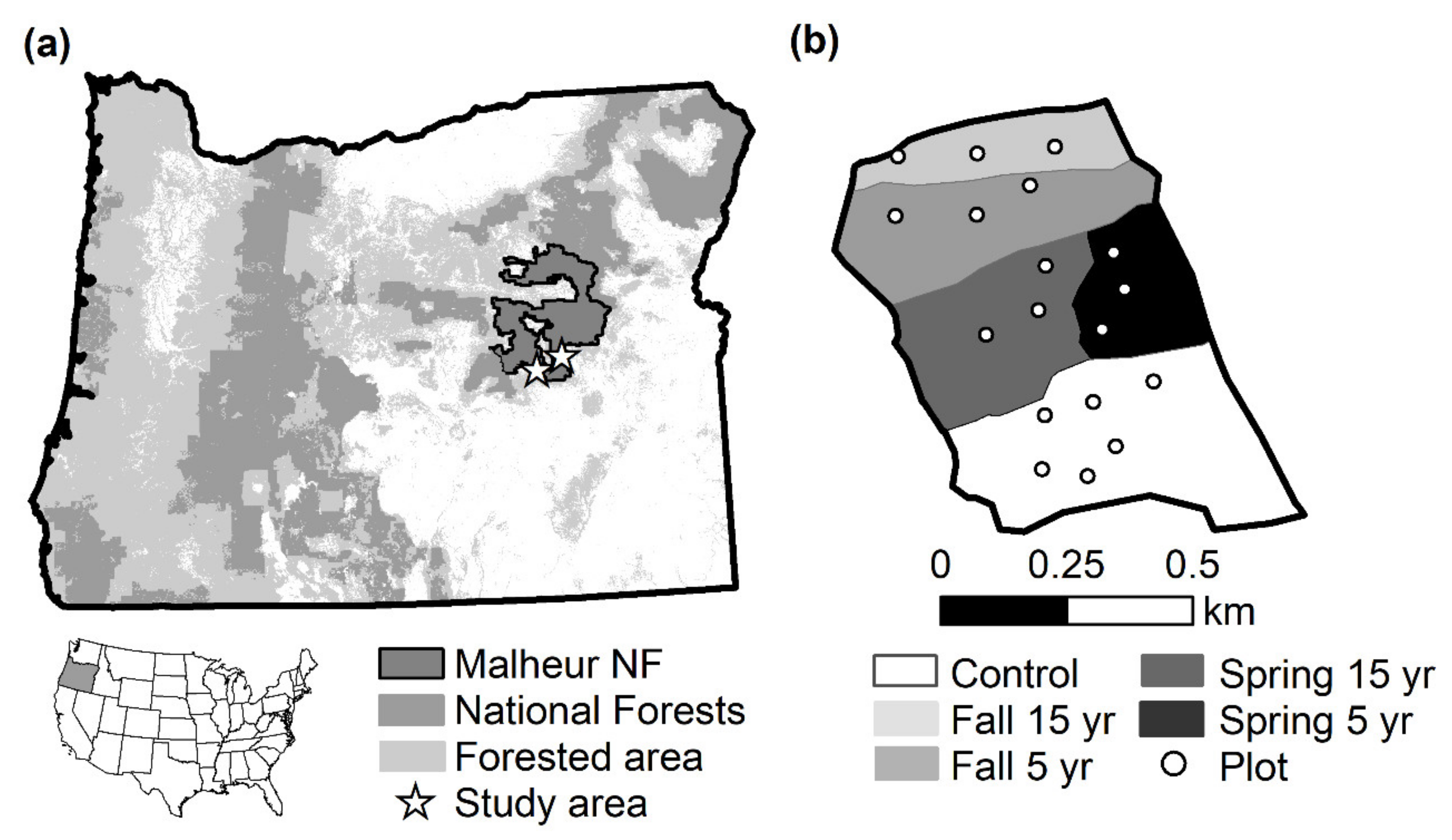
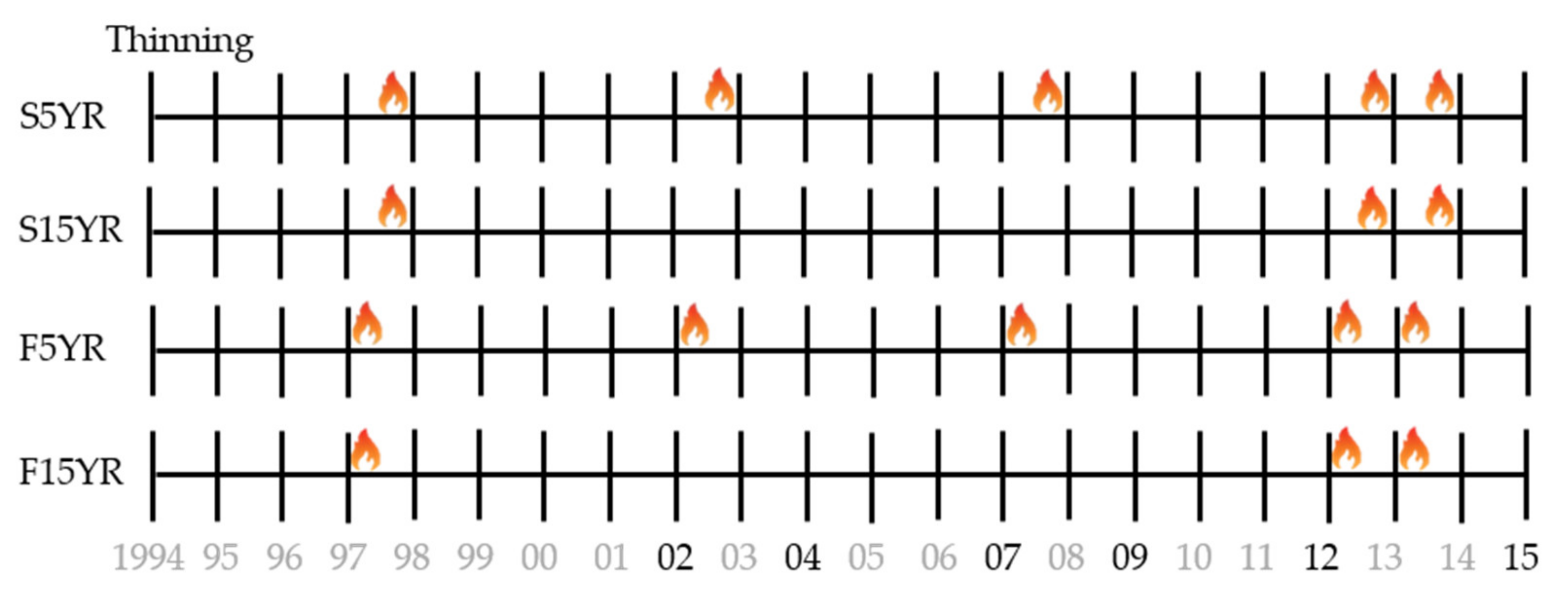
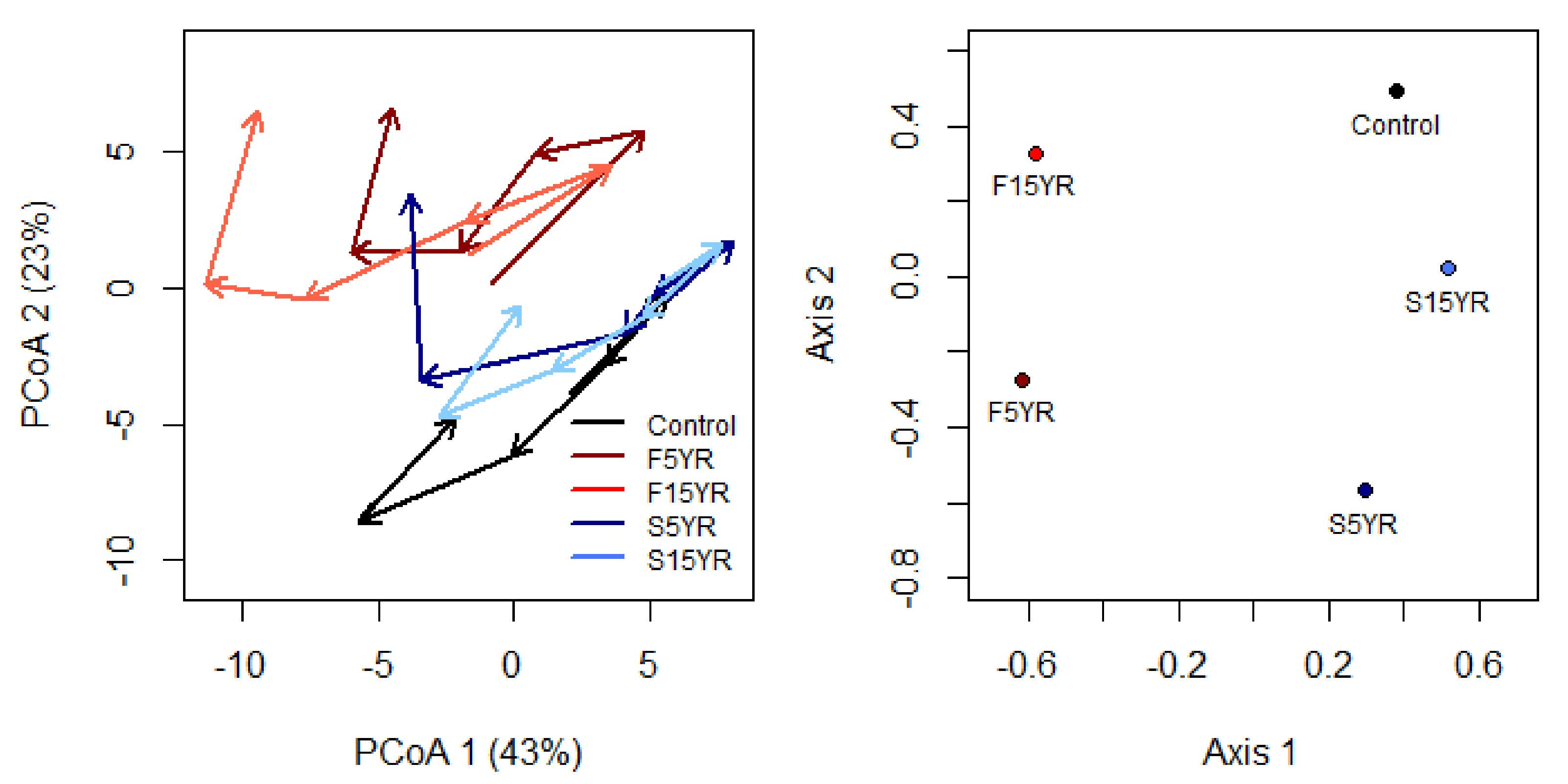
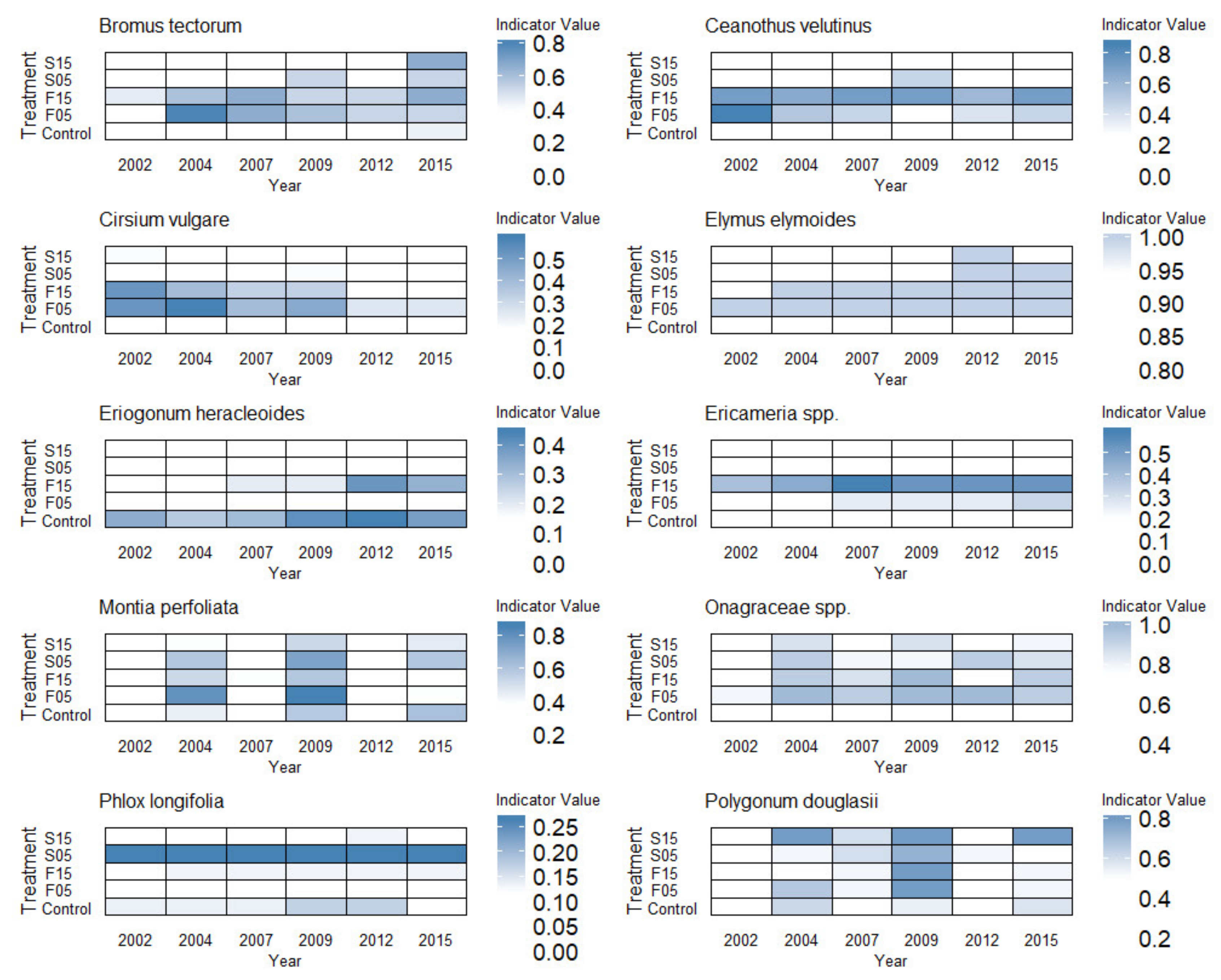
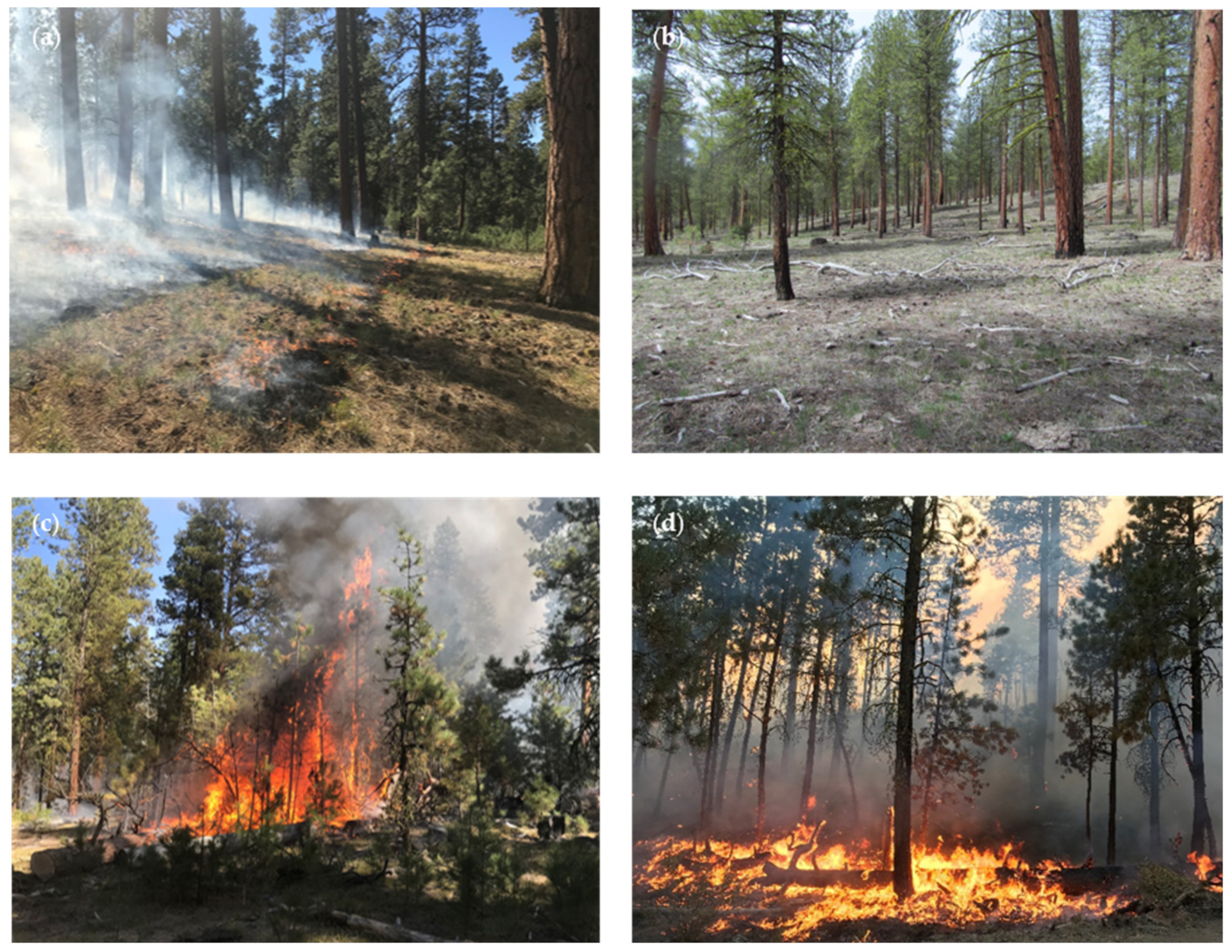
| Year | Source | df | SS | MS | F | P |
|---|---|---|---|---|---|---|
| 2002 | Season | 2 | 1.49 | 0.74 | 2.10 | 0.0050 |
| Interval | 1 | 0.24 | 0.24 | 0.69 | 0.7610 | |
| Total | 88 | 31.84 | ||||
| 2004 | Season | 2 | 1.58 | 0.79 | 2.56 | 0.0010 |
| Interval | 1 | 0.31 | 0.31 | 1.02 | 0.3900 | |
| Total | 88 | 28.08 | ||||
| 2007 | Season | 2 | 1.44 | 0.72 | 2.23 | 0.0130 |
| Interval | 1 | 0.23 | 0.23 | 0.72 | 0.7040 | |
| Total | 88 | 29.15 | ||||
| 2009 | Season | 2 | 1.42 | 0.71 | 2.25 | 0.0060 |
| Interval | 1 | 0.31 | 0.31 | 0.98 | 0.4410 | |
| Total | 88 | 28.55 | ||||
| 2012 | Season | 2 | 1.05 | 0.53 | 1.63 | 0.0840 |
| Interval | 1 | 0.20 | 0.20 | 0.63 | 0.7560 | |
| Total | 88 | 28.62 | ||||
| 2015 | Season | 2 | 1.09 | 0.54 | 1.76 | 0.0370 |
| Interval | 1 | 0.12 | 0.12 | 0.40 | 0.9550 | |
| Total | 88 | 27.53 |
| Sampling Year | |||||||
|---|---|---|---|---|---|---|---|
| Treatment | 2004 | 2007 | 2009 | 2012 | Mean | sd | rho |
| Unburned | 161.28 | 48.39 | 57.76 | 145.54 | 103.03 | 0.95 | 0.64 |
| Fall 5YR | 126.41 | 86.67 | 105.08 | 97.94 | 103.95 | 0.25 | 0.97 |
| Fall 15YR | 144.29 | 56.51 | 98.03 | 95.62 | 98.32 | 0.55 | 0.86 |
| Spring 5YR | 129.70 | 95.54 | 106.73 | 102.99 | 108.65 | 0.22 | 0.98 |
| Spring 15YR | 120.08 | 67.90 | 84.00 | 134.13 | 101.56 | 0.47 | 0.89 |
| Annual Length by Sample Year | Overall | Overall | |||||
|---|---|---|---|---|---|---|---|
| Treatments | 2002–2004 | 2004–2007 | 2007–2009 | 2009–2012 | 2012–2015 | Length | Directionality |
| Unburned | 5.49 | 3.90 | 5.52 | 7.19 | 6.29 | 28.38 | 0.37 |
| Fall 5YR | 9.65 | 5.36 | 8.49 | 7.07 | 10.91 | 41.47 | 0.38 |
| Fall 15YR | 7.45 | 6.34 | 8.74 | 6.72 | 11.93 | 41.18 | 0.42 |
| Spring 5YR | 4.34 | 4.60 | 6.35 | 10.53 | 8.33 | 34.15 | 0.45 |
| Spring 15YR | 4.26 | 4.78 | 6.12 | 6.19 | 6.57 | 27.91 | 0.41 |
| Treatment | Unburned | Fall 5YR | Fall 15YR | Spring 5YR |
|---|---|---|---|---|
| Fall 5YR | 0.73 | |||
| Fall 15YR | 0.60 | 0.33 | ||
| Spring 5YR | 0.73 | 0.20 | 0.33 | |
| Spring 15YR | −0.07 | 0.07 | 0.60 | 0.60 |
© 2020 by the authors. Licensee MDPI, Basel, Switzerland. This article is an open access article distributed under the terms and conditions of the Creative Commons Attribution (CC BY) license (http://creativecommons.org/licenses/by/4.0/).
Share and Cite
Zald, H.S.J.; Kerns, B.K.; Day, M.A. Limited Effects of Long-Term Repeated Season and Interval of Prescribed Burning on Understory Vegetation Compositional Trajectories and Indicator Species in Ponderosa Pine Forests of Northeastern Oregon, USA. Forests 2020, 11, 834. https://doi.org/10.3390/f11080834
Zald HSJ, Kerns BK, Day MA. Limited Effects of Long-Term Repeated Season and Interval of Prescribed Burning on Understory Vegetation Compositional Trajectories and Indicator Species in Ponderosa Pine Forests of Northeastern Oregon, USA. Forests. 2020; 11(8):834. https://doi.org/10.3390/f11080834
Chicago/Turabian StyleZald, Harold S. J., Becky K. Kerns, and Michelle A. Day. 2020. "Limited Effects of Long-Term Repeated Season and Interval of Prescribed Burning on Understory Vegetation Compositional Trajectories and Indicator Species in Ponderosa Pine Forests of Northeastern Oregon, USA" Forests 11, no. 8: 834. https://doi.org/10.3390/f11080834
APA StyleZald, H. S. J., Kerns, B. K., & Day, M. A. (2020). Limited Effects of Long-Term Repeated Season and Interval of Prescribed Burning on Understory Vegetation Compositional Trajectories and Indicator Species in Ponderosa Pine Forests of Northeastern Oregon, USA. Forests, 11(8), 834. https://doi.org/10.3390/f11080834





